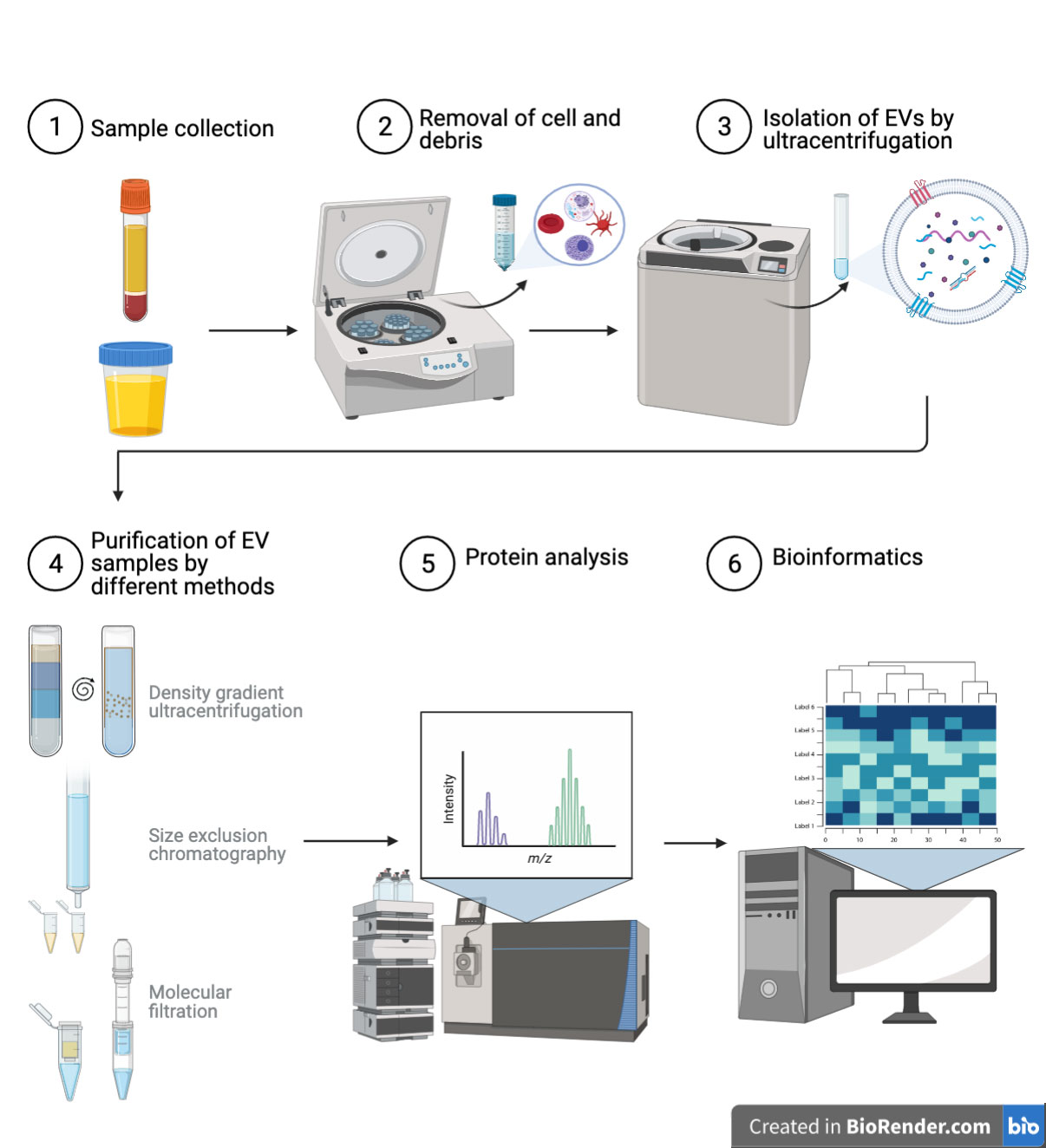Human EVs
EVs released by human cells are the most studied ones due to their function in physiology including their roles in the regulation of the immune system, memory, and reproduction. EVs are widely distributed in the body and readily available in different body fluids. Their purification from body fluids however is challenging and requires specific expertise.
At EVs &MS, for the studies of human EVs, we employ an integrated workflow that combines isolation and purification methods specifically set up for bio-fluids, quantitative proteomics, and bioinformatics (Figure). We develop novel methodologies for the isolation and purification of EVs from urine and plasma. 1–6 Our patented protocol for the isolation of urine EVs relies on gradient ultracentrifugation using a sucrose-deuterium oxide double cushion method and employs a specific buffer that helps to remove co-purifying uromodulin (also known Tamm-Horsfall proteins) from the EV samples.7 For the discovery of novel potential biomarkers, we apply quantitative proteomics. Using this approach our studies demonstrated the alteration of the urinary EV protein profiles in polycystic kidney disease3 and type 2 diabetes.2
Recent studies at EVs & MS lab are aiming at establishing a reproducible method based on the combination of size exclusion chromatography, molecular filtration, and gradient ultracentrifugation for the isolation of highly pure plasma EVs suitable for downstream biomarker analysis. Plasma EVs protein biocargo is a popular resource of disease-specific biomarkers. The majority of EV biomarker studies have focused on the discovery of cancer, cardiovascular, pulmonary, and neurological diseases related biomarkers. Moreover, the role of EVs in viral diseases, including COVID-19 is increasingly recognized today.8 Also, EVs are proposed as therapeutic agents, and delivery vectors for drugs and vaccines nowadays. In this aspect, we are interested in the application of plasma EVs in tissue regeneration and wound healing processes.
Bioinformatics is a key element that implements the proteomics workflow with functional annotation, enrichment analysis, and data mining. Recent work at EVs & MS has defined the human EV membranome, a database of the EV membrane proteins that are involved in uptake, EV-cell interaction, and cellular communication.9
References
- Amal Raj, D. A., Fiume, I., Capasso, G. & Pocsfalvi, G. Urinary Exosomes for Protein Biomarker Research. in Proteomics - Human Diseases and Protein Functions (2012). doi:10.5772/30094
- Stanly, C. et al. Urinary extracellular vesicles: single patient analysis for clinical applications. Adv. Biomembr. Lipid Self-Assembly (2020). doi:10.1016/bs.abl.2020.09.004
- Pocsfalvi, G. et al. Urinary extracellular vesicles as reservoirs of altered proteins during the pathogenesis of polycystic kidney disease. Proteomics - Clin. Appl. 9, 552–567 (2015).
- Raj, D. A. A., Fiume, I., Capasso, G. & Pocsfalvi, G. A multiplex quantitative proteomics strategy for protein biomarker studies in urinary exosomes. Kidney Int. 81, (2012).
- Choi, D. S. Urinary extracellular vesicles for biomarker source to monitor polycystic kidney disease. Proteomics - Clinical Applications 9, 447–448 (2015).
- Lener, T. et al. Applying extracellular vesicles based therapeutics in clinical trials - An ISEV position paper. J. Extracell. Vesicles 4, (2015).
- Amal Raj, D. A., Fiume, I., Capasso, G. & Pocsfalvi, G. Urinary Exosomes for Protein Biomarker Research. in Proteomics - Human Diseases and Protein Functions (InTech, 2012). doi:10.5772/30094
- Pocsfalvi, G. et al. COVID-19 and Extracellular Vesicles: An Intriguing Interplay. Kidney and Blood Pressure Research 45, 661–670 (2020).
- Ramos Juarez, A. P., Trepiccione, F., Capasso, G. & Pocsfalvi, G. The human EV membranome. Adv. Biomembr. Lipid Self-Assembly 32, 53–82 (2020).

